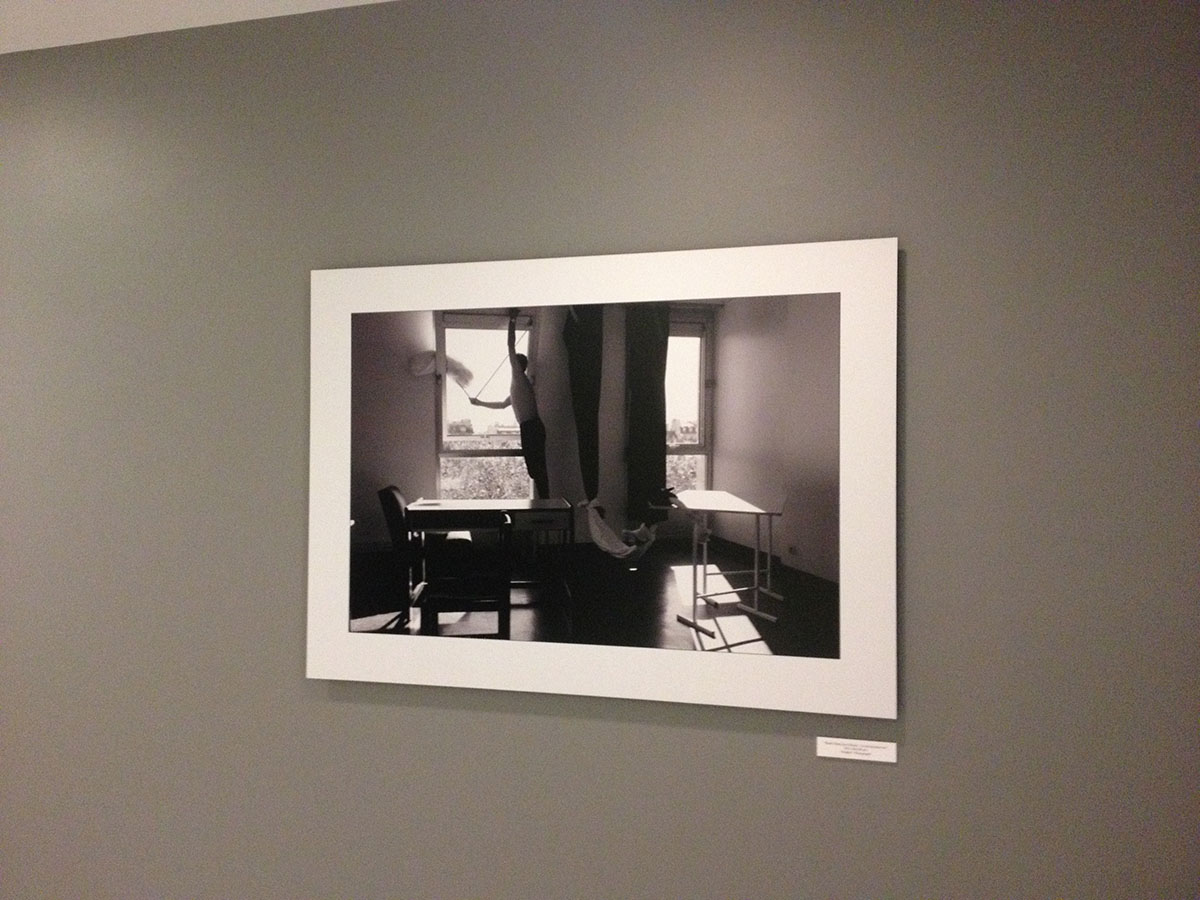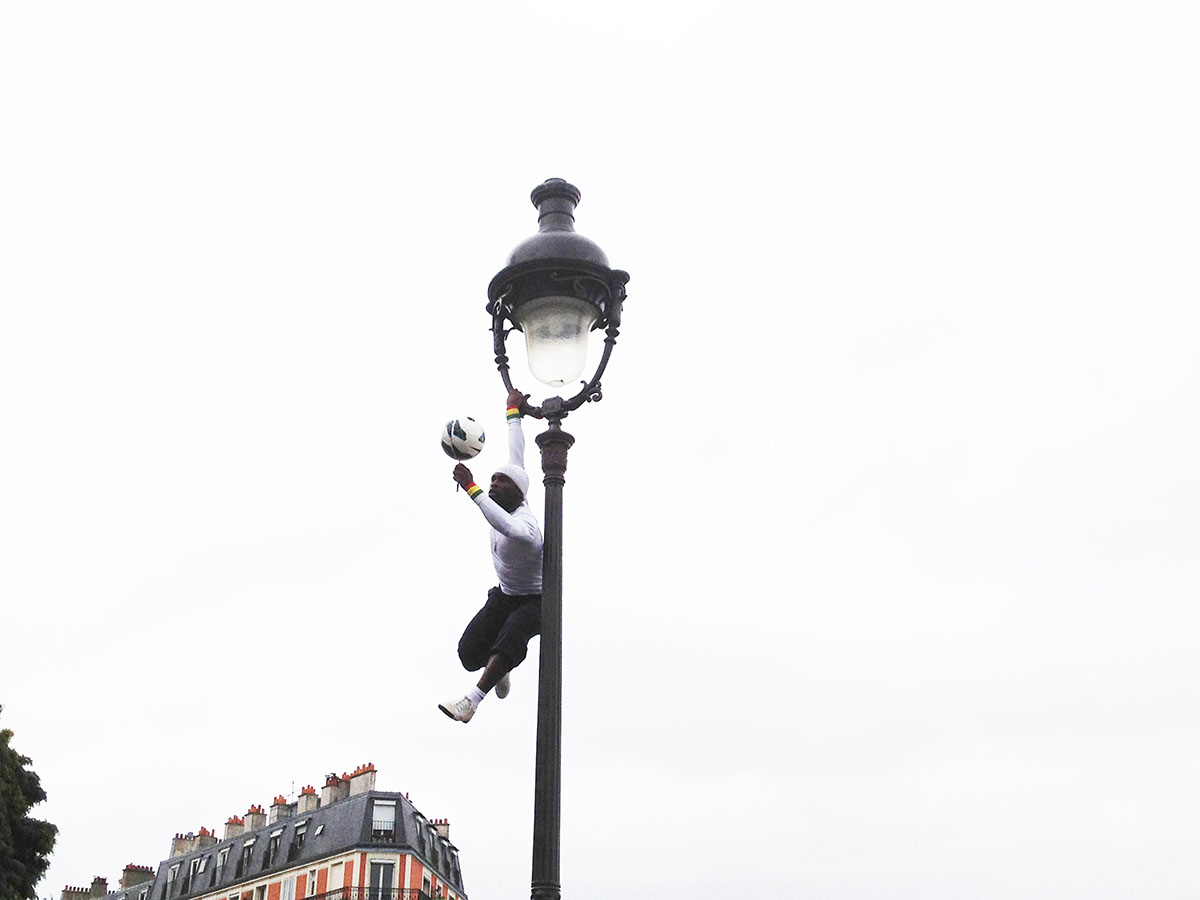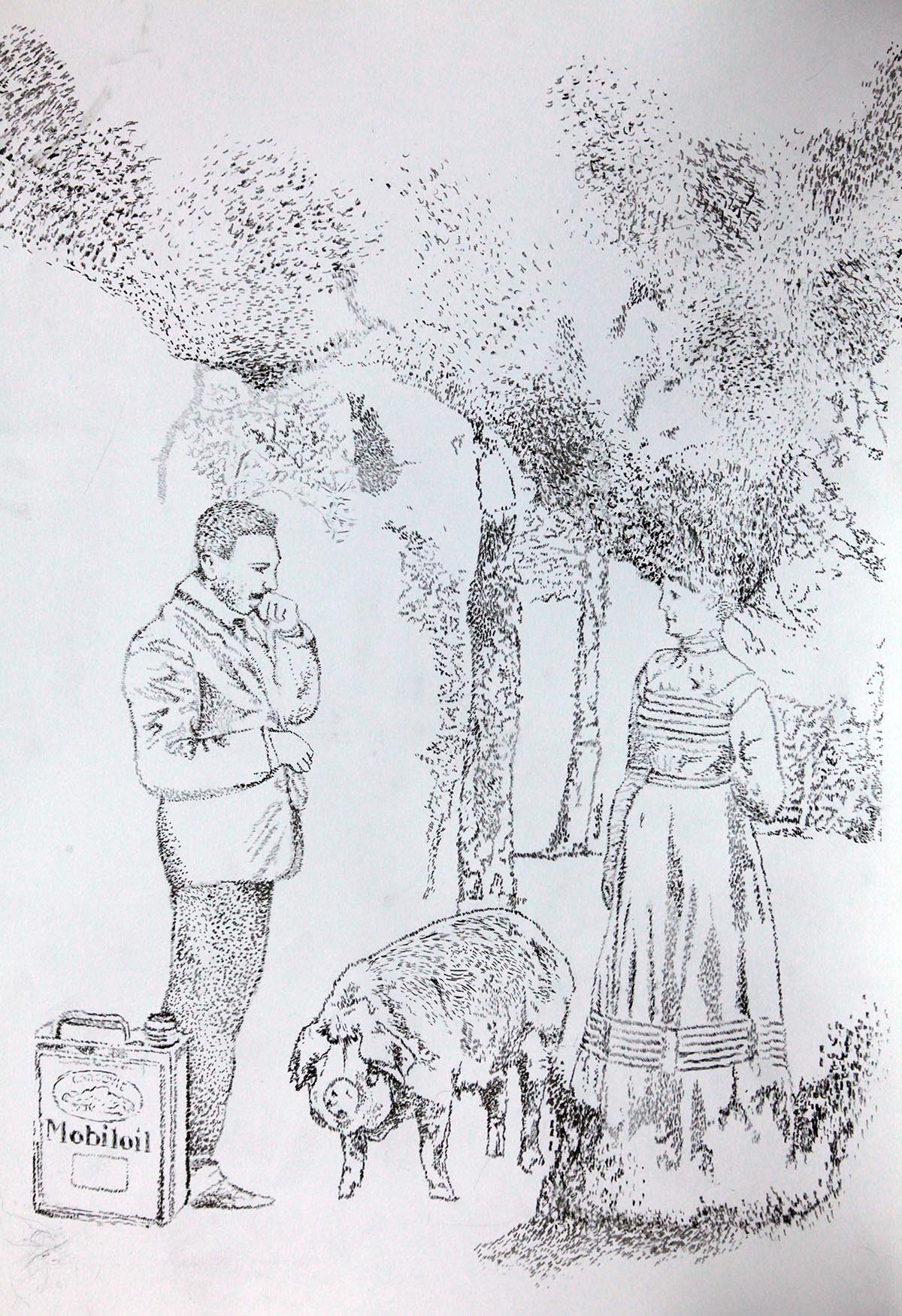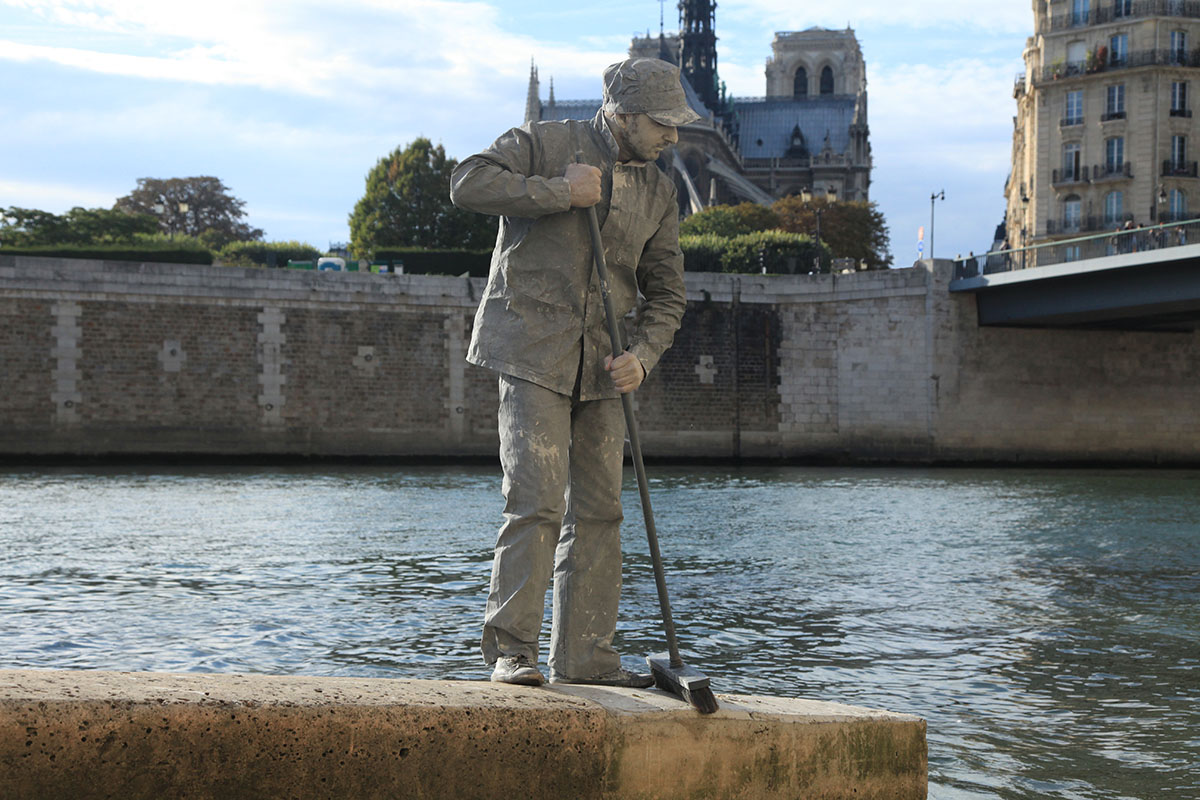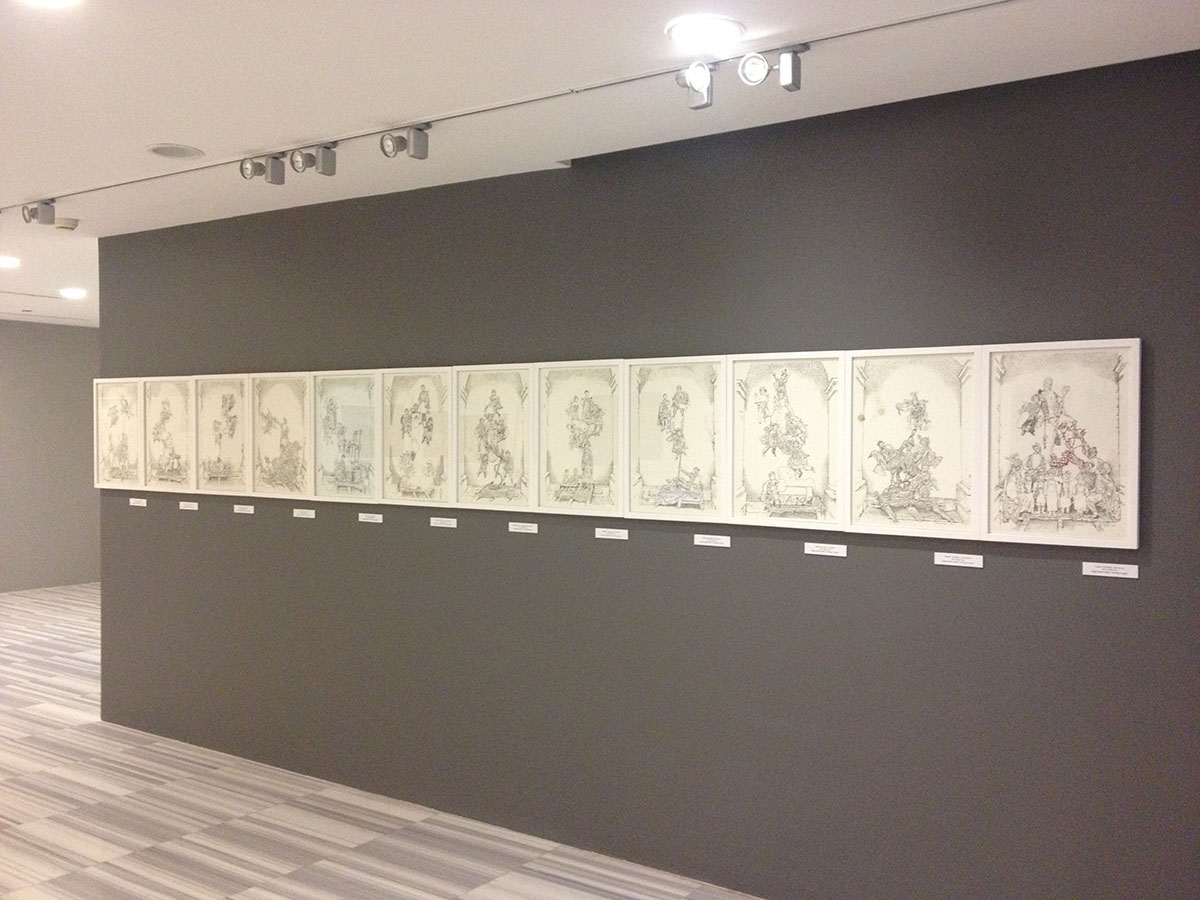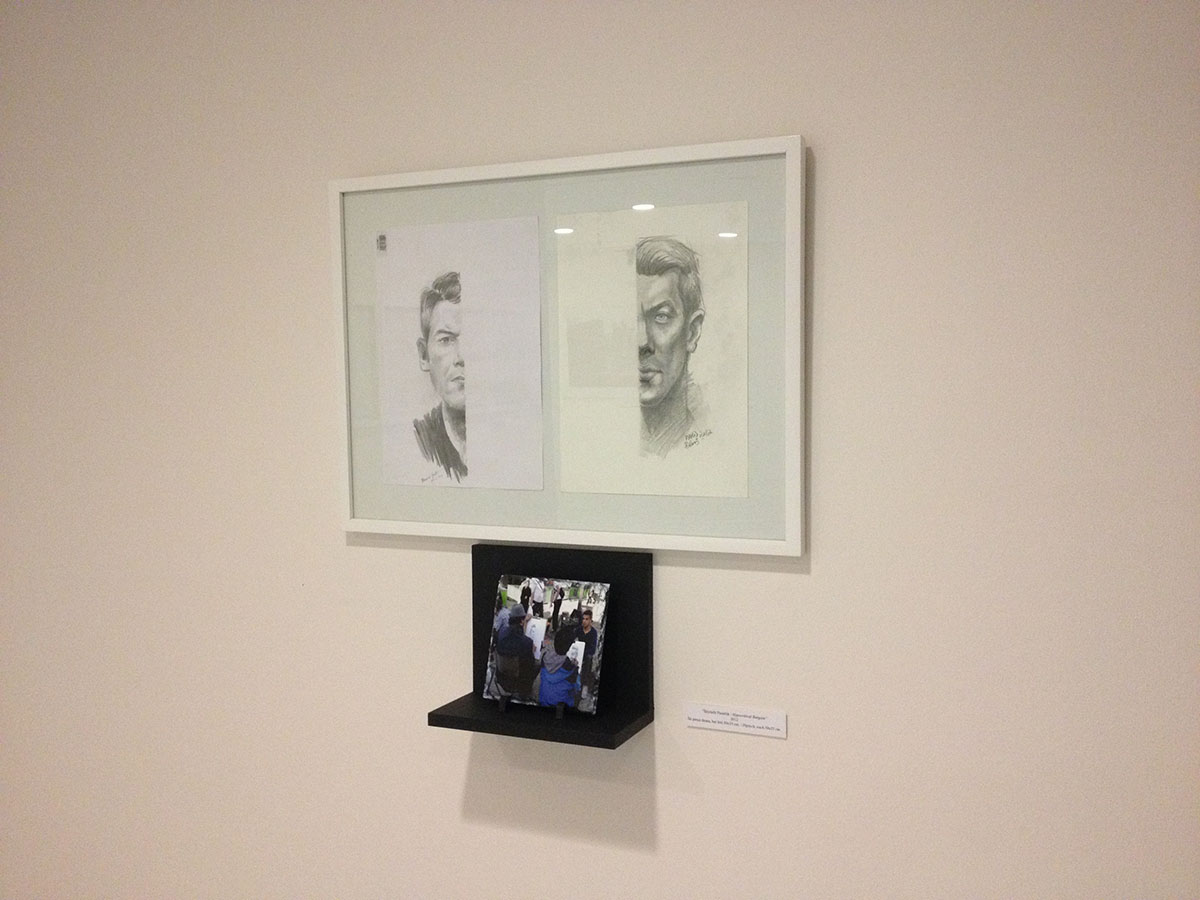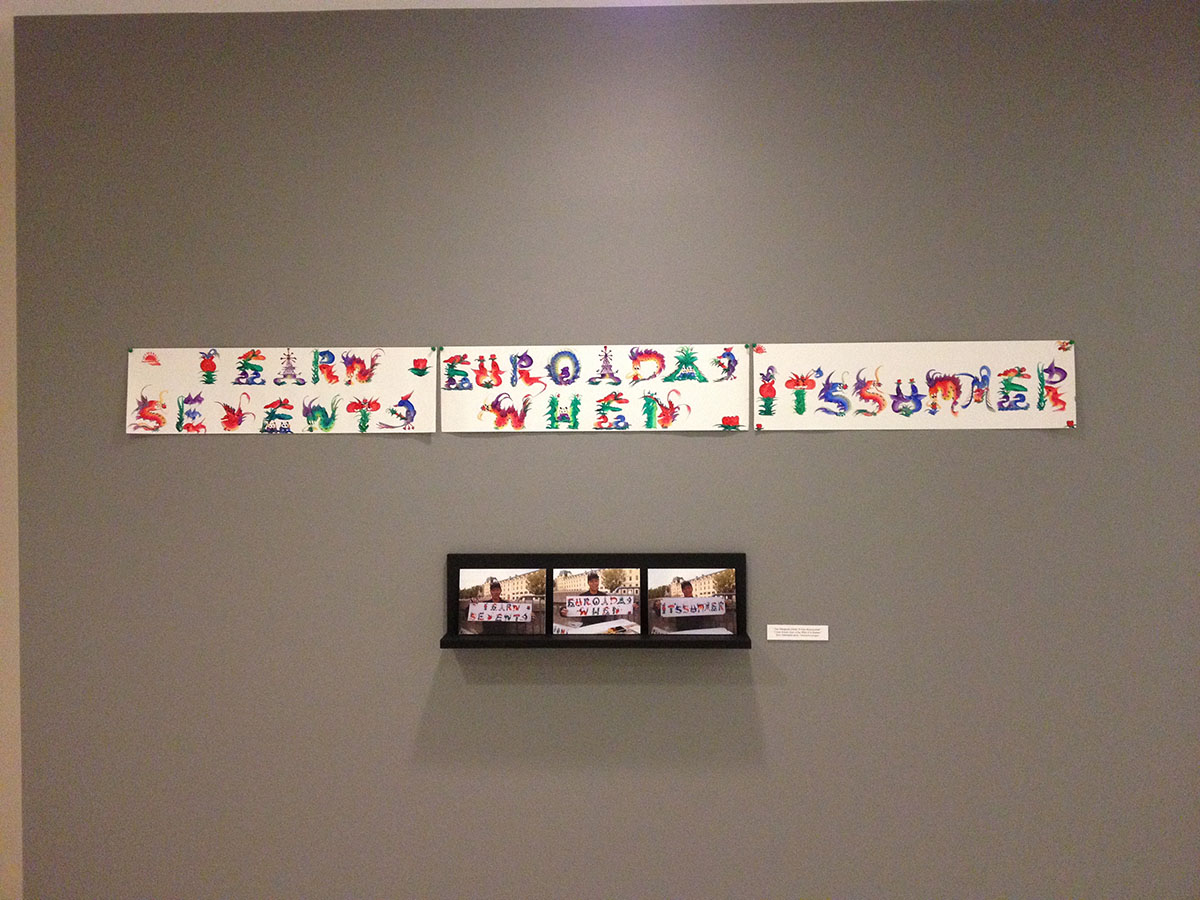Ferhat Özgür ile ‘Tuhaf Ânlar’dan Kalanlar...
Nisan 2014, İstanbul
Derya Yücel
Derya Yücel: Merkez ve periferi arasındaki sınırları, kesişmeleri, göç, inanç, kimlik ve kent gibi kültürel fenomenler üzerinden ele aldığın çalışmalarında kişisel hafızan çoğunlukla ön plandadır. Öte yandan, izleyiciyi kendi tanıklığına ortak etmekte de incelikli üslubunu hep korumuşsundur. 2008’den bu yana Türkiye’de gerçekleştirdiğin ilk kişisel sergin olan ‘Tuhaflıklar Ânı’ da genel olarak pratiğinin ağırlık merkezini oluşturan yaklaşımların ve yine farklı medyumlar arasındaki ilişkiler kendini göstermekte. Biraz arka plan bilgisi vermek için konuşmaya geriden başlayalım, biyografik bir giriş yapalım isterim.
Ferhat Özgür: Ankara’da doğdum ve akademik eğitimimi aynı şehirde tamamladım. 1989 yılında Gazi Üniversitesi Eğitim Fakültesi Resim-İş Eğitim Bölümü’den mezun oldum, lisans üstü eğitimimi de Hacettepe Üniversitesi Güzel Sanatlar Fakültesi Resim Bölümü’nde tamamladım. 1993-2010 yılları arasında Hacettepe Üniversitesi’nde akademisyen olarak çalıştıktan sonra İstanbul’a yerleştim. Çocukluğum ve ilk gençlik yıllarımın büyük bir bölümü Ankara Kalesi etrafında konumlanan Altındağ bölgesinde geçti. Ağırlıklı olarak Orta Anadolu göçmenlerinin yerleştiği tam bir varoş bölgesiydi, yoksulluk diz boyuydu diyebilirim. Ama bu tür nitelemelerden ısrarlı bir biçimde kaçınırım, çünkü fukara edebiyatına düşmek istemem. Genelde mutlu bir çocukluk geçirdiğimi söyleyebilirim. Aile ilişkileri bağlamında çocukluk yıllarımdan kalma travmaların olmadığını görüyorum. Başta okuma yazma bilmeyen rahmetli annem olmak üzere, erken yaşında hayata veda eden babam ve diğer kardeşlerimden hiç bir baskı görmedim. Yalnız Altındağ’ın siyasal ve kültürel iklimi üzerinde kısaca durmak gerekir. Çünkü burası hem sanat okumama karar vermemde hem de neler yapabileceğimi belirlememde önemli bir etmendi. Bizim yaşadığımız sokak, ilginçtir hep ikilemler üzerine konumlanmıştı. Sağ tarafında Büyük Ankara Hastanesi vardı, 1930’lu yıllarda Alman profesörlerin görev yaptığı bir yerdi ve görece olarak da Alman mimarisinin izlerini taşıyordu. Sokağın sol tarafında ise Ulucanlar Yarı Açık Ceza Evi vardı. 1972’de Yusuf Aslan, Deniz Gezmiş ve Hüseyin İnan burada idam edildiğinde ben ilkokula başlıyordum. Mahalle arasında oynarken hapishaneden firar eden mahkumlarla, hastaneye gelen ağır yaralı hastaları aynı anda görmek, hayat ve kurgu arasında gidip gelmek gibiydi. Öte mahallenin ağabeyleri sağcı/milliyetçi cephenin savunucuları iken sol eğilimli Aktaş bölgesi komşu mahalleydi. Özelde bizim mahalle genelde de ara bölge olarak Altındağ sağ sol çatışmasının şiddetli bir biçimde yaşandığı yetmişli yılların en sıcak noktalarından biriydi.
D.Y: Bu koşulların sanatsal eğilimini biçimlendirmende ve ilk dönem üretimlerinde etkisi olduğunu biliyorum. İçerik bağlamında bir yöne ilerlerken mecra çeşitliliğinin habercisi olan bazı denemelerin de olmuş. Kırılma noktaların diyebiliriz. Yaşadığın dönem ve çevrenin, sanatçı kimliğine ve biçim/içerik açısından çalışmalarına etkisinden bahsedebilir misin?
F.Ö: Bizim çocukluğumuzda televizyon tek kanallıydı ve her pazar mutlaka bir kovboy filmi (spaghetti western) yayınlanırdı. Mahalle arkadaşlarımızla bizim için en heyecan verici gün Pazar günüydü. Çünkü bu filmlerin ardından hemen sokağa dökülür ve filmi taklit eder, ‘kovboyculuk’ oynardık. Çoğunlukla ben Amerikan yerlilerini canlandırırdım. Bu türden bir taklit etme güdüsü hem hayat ve kurguyu aynı anda deneyimleme olanağı vermiş hem de sinemaya olan ilgimin artmasına yol açmış olmalı. Tümüyle sanat yapmaya karar verdiğim yıllarda da Altındağ-Ulucanlar bölgesi gerek içeriksel gerekse biçimsel olarak çalışmalarımın ana zeminini oluşturdu diyebilirim.
Örneğin, akademik eğitim yıllarına dönersem, 1990’ların başında, Hacettepe’de atölye hocam Zahit Büyükişliyen’in mekana özgü bir enstalasyon projesi ödevi vermişti. Böyle bir medyum o yıllar o kadar yaygın değildi Türkiye’de. Ankara’dan dışarı adımını atmamış, görüp görebildiği sanat yapıtları Devlet Resim ve Heykel Sergileri, DYO gibi yarışmalı sergilerden ve bir kaç adet sanatçı kitabındaki örneklerden ibaret olan bir sanatçı adayı için ‘mekana özgü’ denilen bu kavramdan oldukça heyecanlanmıştım. Tek odalı bir gecekonduda yaşadığım için, yaşadığım odayı Rilke’nin ‘Genç Bir Şaire Mektuplar’ından hareketle ‘Genç Bir Şairin Odası’na çevirmiştim: Yerlerde tonlarca sigara izmariti, üzerinde karalamalar ve notlar bulunan buruş buruş oraya buraya saçılmış kağıt parçaları, dağınık kitaplar, üzerinde bir daktilo ve çay bardağının olduğu bir çalışma masası vs. Sanki genç şair şiir yazmaya çalışıyor ama olmuyor ve yazdıklarını yırtıp yırtıp ortalığa atıyor, bir nevi yaratma sancısı çekiyor. Bilmiyorduk ki o zaman, mekanın ve düzenin fotoğrafı yok elimde. Hocama da çalışmayı evde göstermiştim. Bir de Ankara Devlet Resim ve Heykel Müzesi’nde (Destek-Yüzey) ‘Support-Surface’ akımının en önemli temsilcilerinden biri olan Claude Viallat’ın inanılmaz derecede büyüleyici kişisel sergisini görmüştüm. Benim için bir kırılma noktasıdır o sergi. Cesaret toplamıştım adeta.
D.Y: Nasıl bir cesaretten bahsediyorsun? Bunu yaşadığın koşulların yapıtlarına olan etkisiyle yine ilişkilendirmeni isteyeceğim.
F.Ö: Viallat resim şasisinden vaz geçmiş ve metrelerce büyüklükte, taşınabilen resimler yapıyordu. Yaşadığım alan topu topu dört beş metrekarelik bir alandı. Ben de büyük boyutlu renk lekeleriyle oynamak ve daha deneysel bir zeminde adeta yıpranmak istiyordum. Sonrası o kadar güzel anılarla yüklü ki benim için: Annem toz halindeki kumaş boyalarını kazanlarda kaynatıyordu, ben de Ulus’taki çadırcılardan ve hurdacılardan edindiğim büyük boyutlu bezleri bu boyalı kazanlara batırıp renklendiriyordum. Sonra da üzerinde motiflerle oynuyordum, ozonla soldurup rastlantısal imgeler elde ediyordum. Büyük boyutlu bezleri ütüleyip katlıyor ve plastik torbalarda depolayabiliyor ve her yere kolayca taşıyabiliyordum. İşlerin bir nevi göçebeliği söz konusuydu. Kimi dönem arkadaşlarım ‘Aaaa, Viallat’nın izinden gidiyor’ demişlerdi ama bundan gurur duymuştum. Bence herkesin bir ustası olmalıydı.
D.Y: Ve bir ilham kaynağı. Yaşadığın semt ve mahalle ile kurduğun gerçekçi ve duygusal yoğunluğun bir bakıma uzun zaman senin ilham kaynağın olmuş. 6. Berlin Bienali’nde birlikte çalıştığın küratör Kathrin Rhomberg, uzun bir zaman dilimini geçirdiğin sokakta yaptığın ‘Bugün Herkes Dışarı’ adlı (2002) ikili fotoğrafın için “tüm yapıtlarının toplandığı bir merkez” nitelemesini yapmıştı. Fotoğraf ve videoya da yöneldiğin bu yıllarda yaptığın bu çalışmada yine aynı sokak baş rolde! Ben bu çalışmanın, hem bu dokuyu hafızana kazıyarak, kendi gerçekliğin olarak ele aldığın içeriden bakışa, hem de yabancılaşmadan/sömürmeden uygun bir mesafe oluşturduğun dışarıdan bakışa sahip olduğunu düşünüyorum.
F.Ö: Evet, yıllar sonra da doğup büyüdüğüm bu sokağa gidip geliyordum. Çünkü ailem hala oradaydı. Bir Pazar günüydü. Fotoğraf makinamla gittim. Kimseye de ne yapacağımı söylemedim aslında. Tek tek mahallelinin kapısını çaldım ve onlardan dışarı çıkmalarını istedim. Çünkü biliyordum ki bu sokak bir daha asla var olmayacak ve mahalleli de asla aynı biçimde bir araya gelemeyecekti. ‘Hatıra fotoğrafı çektireceğiz’ dedim. Onlardan benzeri olmayan bir ânı ortak olarak deneyimlemelerini istiyordum. Mahalleliyi sokak boyunca sıra sıra dizdim ve sokağın bir girişinden bir de çıkışından fotoğrafladım.
D.Y: Daha çok yurt dışında dolaşımda olan bir sanatçı olarak ender aralıklarla kişisel sergi açıyorsun. Bu esnada da bir sürü iş birikiyordur eminim. Türkiye’de kişisel sergi gerçekleştirme koşullarının zorluğu nedeniyle gösteremediğin onlarca iş. Sergide yer alan yapıtlar üzerine konuşalım şimdi. 2013 tarihli ‘Günden Kalanlar’ adlı video ve farklı dönemlerde ürettiğin fotoğraf, desen ve suluboya üretimlerinden oluşan yüzey işlerine odaklandık. Desenlerinde ve suluboyalarında ironi, anti militarist göndermeler, sosyo-politik ve kültürel paradigmaları kurcalıyorsun. Video ve fotoğraflarının ana kaynağı kent ve sokak iken desen ve suluboyalarında metaforlar, pastişler, gerçeküstü ve absürd sahnelerin ağırlığı dikkat çekiyor. Videoda düşsel bir söylemin egemen olduğu sekanslarla dolu sinematografik bir dil söz konusu. Farklı teknikler birbirlerine nasıl eklemleniyorlar? Hangi aşamalardan geçerek sonuca ulaşıyorlar? Ve ‘Tuhaflıklar Ânı’ gibi bir başlığa nasıl referans veriyorlar?
F.Ö: ‘Tuhaflıklar’ tanımlaması Şener Özmen’e ait. Hakkımda yazdığı bir yazının başlığı idi ve genel olarak yapmak istediklerime uyuyordu. Sürekli olarak ve kontrollü bir biçimde üretiyor olmam belki bir dezavantaj. Sanat dünyasının garip kuralları var. Sanki bir işin yeni olması için yapıldığı zaman dilimi içerisinde gösterilmesi gerekiyormuş gibi. Üzerinden bir kaç yıl geçince sanki o iş eskimiş gibi algılanıyor. Tabii ki kabul edilemez bir durum. İşlerin yapıldığı zaman diliminde hemen gösterilmesi gibi bir acelecilik ‘gündem’ oluşturmadan başka bir işe yaramıyor. Tam tersine bir yapıt üretildiği zaman diliminin ardından daha geç bir vakit ortaya çıktığında eğer ayakta durabiliyorsa sağlam bir zemine basıyor demektir. O yüzden kişisel sergi açmakta hiç bir zaman acele etmiyorum. Buradaki işler de bildiğin gibi dört beş yıllık zaman dilimine yayılıyor. Gerek video, gerek fotoğraflarda aslında çalışmaların tümüne ait olan performatif bir kurgu söz konusu. Bu kurgunun çıkış kaynağı benim için yine kent. Şöyle ki, çizim yaparken ya da suluboya çalışırken bir sahne performansının tasarısını yapar gibi hareket ediyorum. Bu anlamda bu çizimlerin hepsini bir performansa ya da heykele dönüştürülebilecek çalışmalar olarak algılıyorum. Kağıt üzeri çalışmalarda kullandığım imgeler gökyüzünden inen imgeler değil. Boşlukta var olmuyorlar. Tersine gazeteler, dergiler, eskicilerden topladığım fotoğraflar, bir yığın atık malzeme ve hazır buluntuları elde ettiğim kaynak yine kent, ya da daha genel anlamıyla dışarısı. Doğal olarak dışarı çıkamazsam imge oluşturamam. “Günden Kalanlar’ adlı video da bu anlamda kağıt üzeri çalışmaların performatif anlamda canlandırılması gibi tasarlandı. Sürekli olarak dağılıp çözülen ve yeniden birleşen karmaşık hikayeler toplamı. Tıpkı bir rüya gibi. Rüyanın doğasında gerçek ve ötesi durumlar aynı anda vuku buluyor. Filmin başından sonuna aktörler hey aynı ama deneyimledikleri hayatlar sürekli değişiyor.
Böylece, mantık ve akıl yürütme bağlamında bu türden biraradalık durumunu ‘Tuhaflıklar Ânı’ olarak tanımlamak en doğru tercih oldu. Kağıt üzeri çalışmalarda sürekli olarak yolunda gitmeyen bir durumla karşı karşıyayız. Farklı imgeler üst üste binmiş ya da yan yana gelmiş, garip, tam okunamaz, yoruma açık, kesin bir anlama bağlanamayacak metaforlar yumağı yaratmaya çalışıyorum. Bilinç bu noktada devrede. Ancak her bir işin kesin anlamlarını verirsem yanlış yoldayım demektir. Şu karıştırılmasın: Bir yapıtın, ya da projenin çıkış yolunu izah etmek başka bir şey, onun izleyicide oluşturabileceği anlamları önceden belirlemek başka bir şey. İkincisi yapıtı kendi içine kapatır.
D.Y: “Günden Kalanlar’, performatif bir video olarak tanımlanabilir. Kağıt üzeri çalışmalarında gözlemlenen pastiş-kolaj yaklaşımının hareketli versiyonu bu anlamda. Farklı işleyen, çelişkili görünen kavramları da yan yana getirmekte incelikli bir manevraya sahip bana göre.
F:Ö: Daha açık söylersem süreç şöyle gerçekleşiyor: Tüm meselem farklı imgelerin bir araya geldiğinde yaratacağı çoğulcu söylemin olanakları. 1990’larda ‘Toprak’ adlı resimlerimi oluştururken, çizimlerimi ve kağıt üzeri mürekkep çalışmalarımı yırtıyor, paramparça ediyor ve tuvalin üzerine serpiştiriyordum. Sonra bu dağınık grubu tutkalla yapıştırarak yüzeyde sabitliyordum. İmgeler önce gerçek ve tanınabilirken parçalamayla yarı gerçek bir görünüme geçiyordu. Benzer bir parçalama ve birleştirme yıllar sonra ‘Günden Kalanlar’da da söz konusu oldu.
D.Y: Genel olarak sanatsal pratiğin bir mesafe ve tanıklığı koruyor hep ve çoğu işinde hafıza kaydedici ve bellek tutucu bir pozisyon alıyorsun. Kadın meselesi dışında alt kültür, kentsel dönüşüm, göç ve kayıt dışı emeğin kent ekonomisine entegrasyonu gibi konulara odaklandığın işlerin de var. ‘Biz Hurda Sesleriyle Konuşuruz’, ‘Bugün Günlerden Pazartesi’, ‘Misket’, ‘Kucaklaşma’ ve ‘Şarkı Söyleyebilirim’ gibi videoların da bu yönde gelişen üretimler. 2012 yılında Paris’te Cite des Arts konuk sanatçı sürecinde ürettiğin işleri o ortamdaki atölyende gördüğümde de, kent-emek-yaratıcı ekonomi üçgenini düşündüm. Sokak ressamları ve göstericileriyle yaptığın katılımcı, ortak projeler de vardı örneğin. Bunlardan bahsedebilir misin?
F.Ö: Bu tür ‘misafirlik’ programları benim için tamamen çalışma ve üretme süreci olarak işliyor. Günün büyük bölümünü araştırma ve çalışma ile geçiriyorum. Bir bakıma ödevini yapması gereken bir öğrenci sorumluluğu hissediyorum. Paris’te Cite des Arts’da ortaya çıkan ilk işim ‘İki Yüzlü Pazarlık’ oldu. O kente özgü neler yapabilirim düşüncesiyle sokakta günlerce konu ve malzeme aradım. Meşhur Paris sokak ressamlarının çizim teknikleri, onların hayatlarında ilk kez karşılaştıkları bir yabancının yüzünü betimleme yolları ilgimi çekmişti. Özellikle, bu ressamların çizimlerini, atölyede değil de sokakta gerçekleştirdiklerinde nasıl bir tutum içinde olduklarını da merak ediyordum. Derken ressamların genel çizim alışkanlıklarını tersine çevirecek, onları farklı yönlere sevk edecek stratejiler üzerinde düşünmeye başladım. Bir portrenizi 20 Euro’ya çiziyorlardı. Tek bir ressama portremi yaptırmak yerine iki ayrı ressama aynı anda iki portre çizmeleri önerisinde bulundum. Fakat bir farkla: ressamlardan biri yüzümün sol tarafını diğeri de sağ tarafımı çizecekti ama istedikleri paranın yarısı olan 10 Euro’yu verecektim. Böylece aynı anda iki oto-portrem olacaktı. Fakat nihayetinde ‘iki yüzlü bir pazarlık’ yapmış olacaktım. İşi de böyle adlandırdım.
Başka bir gün de futbol topuyla türlü cambazlıklar yapan Gine’li bir göçmene 10 Euro verip, ondan bir elektrik direğinin tepesine tırmanmasını ve topunu bir ayağının üzerinde tutmasını istedim. Peter adlı bir başka sokak performansçısı da sokakta canlı bir heykele dönüşüyordu. Makul bir ödenek karşılığında, onu bulunduğu yerden alıp Seine nehri kıyısına götürdüm. Ondan gün içinde kazandığı paraları nehre süpürürken gösteren bir çöpçü gibi durmasını istedim. Onu o halde fotoğrafladım. Bir başka projede, turistlerin ismini türlü kaligrafik atraksiyonlarla yazarak para kazanan Çinli bir hattat ile gelişti. Belirli bir ücret karşılığında isminizi kaligrafik olarak kağıt şeritler üzerine yazıyordu. Kendisine günde ortalama ne kadar kazandığını sordum. ‘Yaz olduğunda 70 Euro’ dedi. Ben de, ‘Peki! Sana karşılığını ödeyeceğim ama ismimi yazmak yerine ‘Yaz Olduğunda Günde 70 Euro Kazanıyorum’ ibaresini yazacaksın” dedim. Amacım kendi kazancının kaligrafisini oluşturmasını, meseleyi kendisine döndürmesini sağlamaktı. Böylece sokak performansçılarıyla bir tür işçi ve işveren ilişkisi kurarak kayıt dışı ekonomiye ortak olma arzusu içinde bulunuyordum. Kentin turizm ekonomisi ve emeğin pazardaki tekinsiz konumu dışında ‘sanat piyasası’ kavramına ve sanatçının bu ‘piyasa’daki belirsiz mücadelesine de işaret etmeye çalışmıştım. Çünkü kentler bizi belirliyordu.
D.Y: Evet, kentler bizi belirliyor. Lefebvre’ın da dediği gibi, gündelik yaşam bir toplumu anlamak için başvurabileceğimiz önemli bir ipucudur ve kentsel hayat ise bu ipucunun yakalanacağı asıl ‘mekan’ olarak kabul edilir. Reklamların, magazin sayfalarının ve emlak eklerinin pompalandığı bir zamanda, kentlerin dehşet verici ‘dönüşüm’ çılgınlığı... Şehrin parçalı ve heterojen yapısının üstünü kapatma, gözetlenebilir ve dolayısıyla kolay kontrol edilebilir yapay homojen şehirlerin inşası. İstanbul’da ve pek çok şehirde olanlar gibi. Senin de işaret ettiğin bu yapıya ait gerçek hikayeleri belleğe dahil etmek ve gündelik yaşamın içinde gerçekleştiği mekanları tanımlama kaygısı işlerinde öne çıkıyor. Bu anlamda sosyo-eleştirel bir tavrın var. ‘Biz Ameleyiz!’ (2013) adlı video çalışman da tam olarak bu yaklaşım kendini gösteriyordu.
F.Ö: ‘Biz Ameleyiz!’ kent odaklı diğer video ve fotoğraflarıma eklemlenen bir özelliğe sahip. Ama bu sefer dışarıdan. Dört katlı bir apartmanın tadilatı ve yenilenmesi sürecinde işçilerle bir hafta geçirdim. Ucuz işçi sömürüsüne ilişkin gerçekler ile onların kişisel hayatlarından öykülerle harmanlanan dokümanter bir video hedeflemiştim. Videonun sonunda topu topu dört katlı yenilenmiş bir apartman beliriyor ama bu küçük yapının onarımının arkasında yatan öyküler o kadar çok katmanlı ki, asıl göstermek istediğim şey de buydu.
Sanat bir dikkat çekme işlevi de taşıyor, politik ya da sosyo-eleştirel olarak nitelenen çalışmaların kaynağını da oluşturuyor bu. Ben bu işlere, birer sözlü tarih olarak da bakıyorum. Sanat ve hayat arasındaki ilişkinin kurulması için sanatın mutlak biçimde kamusallaşması gerekmiyor. Kamusal bir proje olunca sanat ve hayat arasındaki ilişkinin kurulma zorunluluğu ‘iç’ ve ‘dış’ kavramlarının eş zamanlı kullanımlarıyla da ilişkili. Çünkü ev içinden dışarıya giden deşifrelerin, özel ve namahrem alanlara yönelik hikayelerin, itirafların ve kişisel deneyimlerin sanat aracılığıyla somutlaştırılması da başka bir kamusallaştırma aracı. Örneğin ‘Aşık Kadınlar’ adlı videoda durum böyle. Kadınlara özgü mahrem öyküleri dinliyoruz ve bu öyküler sözlü tarih aracılığıyla içerden kamusallaşıyor.
D.Y: ‘Aşık Kadınlar’ (2013), ‘Metamorfoz Muhabbet’ (2009) adlı işinle kadınlık meselesi ve modernleşme paradigmaları bağlamında ilişki kuruyor...
F.Ö: Evet, ‘Aşık Kadınlar’, kadın meselesi bağlamında ‘Metamorfoz Muhabbet’le ilişkili. ‘Aşık Kadınlar’da üç kadın arasında vuku bulan biraz kurgu biraz doğaçlama bir sohbete tanık oluyoruz. İtiraflar var. Kadınlardan ikisi hayatta olmayan eşleri hakkında hislerini, düşüncelerini, bazen dedikodu dozunda bazen yad etmeye varan hallerle ifşa ediyorlar. Türkiye’de yabancısı olmadığımız bir kadınlık durumuna şahit oluyoruz. Geleneğin kadın üzerindeki baskısı, erkek şiddeti, haksızlıklar ve güçlüklerle geçen hayatlar. Diğer yandan bu kadınların çelişkilerini de görüyoruz. Mesela kocasının dayaklarından, zorbalığından dem vuran kadın herşeye rağmen kocasına duyduğu aşkı ve bağlılığını haykırıyor. Rahmetli kocasının yine de yanında olmasını istiyor. Bu bana bir prototip gibi geliyor. Özellikle taşra ve varoş yaşamında yaygınlık kazanan, kadına özgü kişisel dramlar.
D.Y: ‘Aşık Kadınlar’da izlediğimiz kadınların bu çelişkili olma halini aslında ortak ve kaygılı bir zemine bağlıyorum. Bunun nedeni kadınların çok küçük yaşta evlen(diril)meleri ile ilişkili, kendilerini tanıyabilecekleri ve kendilerini gerçekleştirebilecekleri tüm olanaklar ya kısıtlanmış ya da tamamen ellerinden alınmış. Kadınlar, baba, koca, oğul gibi yaşamlarını belirlemiş bu figürlere karşı hoşnutsuzluklarını hem itiraf ediyorlar hem de onları olumluyorlar. Burada da, bir yandan zoraki olguların içselleştirildiği diğer yandan bastırılmış bir direncin yarattığı çelişki durumlar söz konusu.
F.Ö: Videodaki kadınlardan birinin adı Hediye. O, oğlunu ölen kocasının yerine koymuş mesela, artık evde onun sözü geçiyor. Eskiden kocasının yaptığı eziyetleri dillendiriyor, anlatıyor ama başka türlü bir olasılığı da bilmiyor. Erkeğin iktidarını ölen kocasından oğluna aktarıyor. Ters giden birşeylerin farkına varmış ama toplumun da rolünün ağır olduğu bu içselleştirmenin izlerini silemiyor. Diğeri kadın ise aile içi şiddete maruz kalmış ve herşeye rağmen hayatta olmayan ama kendisine fiziksel şiddet uygulamış olan kocasının ardından “Olsun, öyleydi böyleydi ama yine de başımda duran bir erkekti, keşke yanımda olsaydı” diyebiliyor. Ataerkil iktidarı sorgulayamayacak kadar güçsüzleşiyor. Videoda da bu kısırdöngüyü sorgulayamayan ve kıramayan kadınların ironik ama iç acıtıcı itirafları söz konusu.
D.Y: Kadın meselesi üzerine giden ender erkek sanatçılardan birisin. Kadın bedenini estetik bir form, bakılası bir nesne olarak ele almıyorsun ya da pasif estetik yapılara büründürmüyorsun. Tersine gerçekçi bir gözle toplumsal fenomenlere dönüştürüyorsun.
F.Ö: Kadın meselesi belki otobiyografik olarak doğallıkla geldi beni buldu denebilir. Yani, çocukluğumun geçtiği Altındağ bölgesi, kadınların hem mağdur hem güçlü olduğu bir nüfusa sahipti. Varoş kültürü demiştik ya. Kadın orada aileyi, evi çekip çeviren, koruyan, yöneten, ayakta tutan bir figürdü. Acılı ama o oranda da baskın, dirayetli ve güçlü bir karakterdi. Ataerkil bir gelenek içinde, sürekli olarak erkeğinin yarattığı sorunlarla (şiddet, hakaret, alkolizm, aldatma vs.) başa çıkmaya çalışan yalnız bir savaşçıydı. Altındağ Türkiye’nin mikro ölçeğiydi aslında ama bize özgü bir büyük resmin genelini yansıtıyordu. ‘Kadın’ doğal olarak otobiyografik ya da sezgisel ama oldukça önemsediğim bir meseleye dönüştü yıllar içinde.
D.Y: Yine de spesifik olarak belirli kavram ve konularla sınırlanmayan, hem içerik hem form olarak çoksesliliğe sahip sanatsal tavrın ‘Tuhaflıklar Ânı’nda kendini gösteriyor. Ferhat Özgür’ün sanat pratiğini tamamen kapsayan bir sergi olmasa da, mütevazi, derin ve izleyicinin aklında yer edinecek bir sergi olduğunu düşünüyorum.
Nisan 2014, İstanbul
Derya Yücel
Derya Yücel: Merkez ve periferi arasındaki sınırları, kesişmeleri, göç, inanç, kimlik ve kent gibi kültürel fenomenler üzerinden ele aldığın çalışmalarında kişisel hafızan çoğunlukla ön plandadır. Öte yandan, izleyiciyi kendi tanıklığına ortak etmekte de incelikli üslubunu hep korumuşsundur. 2008’den bu yana Türkiye’de gerçekleştirdiğin ilk kişisel sergin olan ‘Tuhaflıklar Ânı’ da genel olarak pratiğinin ağırlık merkezini oluşturan yaklaşımların ve yine farklı medyumlar arasındaki ilişkiler kendini göstermekte. Biraz arka plan bilgisi vermek için konuşmaya geriden başlayalım, biyografik bir giriş yapalım isterim.
Ferhat Özgür: Ankara’da doğdum ve akademik eğitimimi aynı şehirde tamamladım. 1989 yılında Gazi Üniversitesi Eğitim Fakültesi Resim-İş Eğitim Bölümü’den mezun oldum, lisans üstü eğitimimi de Hacettepe Üniversitesi Güzel Sanatlar Fakültesi Resim Bölümü’nde tamamladım. 1993-2010 yılları arasında Hacettepe Üniversitesi’nde akademisyen olarak çalıştıktan sonra İstanbul’a yerleştim. Çocukluğum ve ilk gençlik yıllarımın büyük bir bölümü Ankara Kalesi etrafında konumlanan Altındağ bölgesinde geçti. Ağırlıklı olarak Orta Anadolu göçmenlerinin yerleştiği tam bir varoş bölgesiydi, yoksulluk diz boyuydu diyebilirim. Ama bu tür nitelemelerden ısrarlı bir biçimde kaçınırım, çünkü fukara edebiyatına düşmek istemem. Genelde mutlu bir çocukluk geçirdiğimi söyleyebilirim. Aile ilişkileri bağlamında çocukluk yıllarımdan kalma travmaların olmadığını görüyorum. Başta okuma yazma bilmeyen rahmetli annem olmak üzere, erken yaşında hayata veda eden babam ve diğer kardeşlerimden hiç bir baskı görmedim. Yalnız Altındağ’ın siyasal ve kültürel iklimi üzerinde kısaca durmak gerekir. Çünkü burası hem sanat okumama karar vermemde hem de neler yapabileceğimi belirlememde önemli bir etmendi. Bizim yaşadığımız sokak, ilginçtir hep ikilemler üzerine konumlanmıştı. Sağ tarafında Büyük Ankara Hastanesi vardı, 1930’lu yıllarda Alman profesörlerin görev yaptığı bir yerdi ve görece olarak da Alman mimarisinin izlerini taşıyordu. Sokağın sol tarafında ise Ulucanlar Yarı Açık Ceza Evi vardı. 1972’de Yusuf Aslan, Deniz Gezmiş ve Hüseyin İnan burada idam edildiğinde ben ilkokula başlıyordum. Mahalle arasında oynarken hapishaneden firar eden mahkumlarla, hastaneye gelen ağır yaralı hastaları aynı anda görmek, hayat ve kurgu arasında gidip gelmek gibiydi. Öte mahallenin ağabeyleri sağcı/milliyetçi cephenin savunucuları iken sol eğilimli Aktaş bölgesi komşu mahalleydi. Özelde bizim mahalle genelde de ara bölge olarak Altındağ sağ sol çatışmasının şiddetli bir biçimde yaşandığı yetmişli yılların en sıcak noktalarından biriydi.
D.Y: Bu koşulların sanatsal eğilimini biçimlendirmende ve ilk dönem üretimlerinde etkisi olduğunu biliyorum. İçerik bağlamında bir yöne ilerlerken mecra çeşitliliğinin habercisi olan bazı denemelerin de olmuş. Kırılma noktaların diyebiliriz. Yaşadığın dönem ve çevrenin, sanatçı kimliğine ve biçim/içerik açısından çalışmalarına etkisinden bahsedebilir misin?
F.Ö: Bizim çocukluğumuzda televizyon tek kanallıydı ve her pazar mutlaka bir kovboy filmi (spaghetti western) yayınlanırdı. Mahalle arkadaşlarımızla bizim için en heyecan verici gün Pazar günüydü. Çünkü bu filmlerin ardından hemen sokağa dökülür ve filmi taklit eder, ‘kovboyculuk’ oynardık. Çoğunlukla ben Amerikan yerlilerini canlandırırdım. Bu türden bir taklit etme güdüsü hem hayat ve kurguyu aynı anda deneyimleme olanağı vermiş hem de sinemaya olan ilgimin artmasına yol açmış olmalı. Tümüyle sanat yapmaya karar verdiğim yıllarda da Altındağ-Ulucanlar bölgesi gerek içeriksel gerekse biçimsel olarak çalışmalarımın ana zeminini oluşturdu diyebilirim.
Örneğin, akademik eğitim yıllarına dönersem, 1990’ların başında, Hacettepe’de atölye hocam Zahit Büyükişliyen’in mekana özgü bir enstalasyon projesi ödevi vermişti. Böyle bir medyum o yıllar o kadar yaygın değildi Türkiye’de. Ankara’dan dışarı adımını atmamış, görüp görebildiği sanat yapıtları Devlet Resim ve Heykel Sergileri, DYO gibi yarışmalı sergilerden ve bir kaç adet sanatçı kitabındaki örneklerden ibaret olan bir sanatçı adayı için ‘mekana özgü’ denilen bu kavramdan oldukça heyecanlanmıştım. Tek odalı bir gecekonduda yaşadığım için, yaşadığım odayı Rilke’nin ‘Genç Bir Şaire Mektuplar’ından hareketle ‘Genç Bir Şairin Odası’na çevirmiştim: Yerlerde tonlarca sigara izmariti, üzerinde karalamalar ve notlar bulunan buruş buruş oraya buraya saçılmış kağıt parçaları, dağınık kitaplar, üzerinde bir daktilo ve çay bardağının olduğu bir çalışma masası vs. Sanki genç şair şiir yazmaya çalışıyor ama olmuyor ve yazdıklarını yırtıp yırtıp ortalığa atıyor, bir nevi yaratma sancısı çekiyor. Bilmiyorduk ki o zaman, mekanın ve düzenin fotoğrafı yok elimde. Hocama da çalışmayı evde göstermiştim. Bir de Ankara Devlet Resim ve Heykel Müzesi’nde (Destek-Yüzey) ‘Support-Surface’ akımının en önemli temsilcilerinden biri olan Claude Viallat’ın inanılmaz derecede büyüleyici kişisel sergisini görmüştüm. Benim için bir kırılma noktasıdır o sergi. Cesaret toplamıştım adeta.
D.Y: Nasıl bir cesaretten bahsediyorsun? Bunu yaşadığın koşulların yapıtlarına olan etkisiyle yine ilişkilendirmeni isteyeceğim.
F.Ö: Viallat resim şasisinden vaz geçmiş ve metrelerce büyüklükte, taşınabilen resimler yapıyordu. Yaşadığım alan topu topu dört beş metrekarelik bir alandı. Ben de büyük boyutlu renk lekeleriyle oynamak ve daha deneysel bir zeminde adeta yıpranmak istiyordum. Sonrası o kadar güzel anılarla yüklü ki benim için: Annem toz halindeki kumaş boyalarını kazanlarda kaynatıyordu, ben de Ulus’taki çadırcılardan ve hurdacılardan edindiğim büyük boyutlu bezleri bu boyalı kazanlara batırıp renklendiriyordum. Sonra da üzerinde motiflerle oynuyordum, ozonla soldurup rastlantısal imgeler elde ediyordum. Büyük boyutlu bezleri ütüleyip katlıyor ve plastik torbalarda depolayabiliyor ve her yere kolayca taşıyabiliyordum. İşlerin bir nevi göçebeliği söz konusuydu. Kimi dönem arkadaşlarım ‘Aaaa, Viallat’nın izinden gidiyor’ demişlerdi ama bundan gurur duymuştum. Bence herkesin bir ustası olmalıydı.
D.Y: Ve bir ilham kaynağı. Yaşadığın semt ve mahalle ile kurduğun gerçekçi ve duygusal yoğunluğun bir bakıma uzun zaman senin ilham kaynağın olmuş. 6. Berlin Bienali’nde birlikte çalıştığın küratör Kathrin Rhomberg, uzun bir zaman dilimini geçirdiğin sokakta yaptığın ‘Bugün Herkes Dışarı’ adlı (2002) ikili fotoğrafın için “tüm yapıtlarının toplandığı bir merkez” nitelemesini yapmıştı. Fotoğraf ve videoya da yöneldiğin bu yıllarda yaptığın bu çalışmada yine aynı sokak baş rolde! Ben bu çalışmanın, hem bu dokuyu hafızana kazıyarak, kendi gerçekliğin olarak ele aldığın içeriden bakışa, hem de yabancılaşmadan/sömürmeden uygun bir mesafe oluşturduğun dışarıdan bakışa sahip olduğunu düşünüyorum.
F.Ö: Evet, yıllar sonra da doğup büyüdüğüm bu sokağa gidip geliyordum. Çünkü ailem hala oradaydı. Bir Pazar günüydü. Fotoğraf makinamla gittim. Kimseye de ne yapacağımı söylemedim aslında. Tek tek mahallelinin kapısını çaldım ve onlardan dışarı çıkmalarını istedim. Çünkü biliyordum ki bu sokak bir daha asla var olmayacak ve mahalleli de asla aynı biçimde bir araya gelemeyecekti. ‘Hatıra fotoğrafı çektireceğiz’ dedim. Onlardan benzeri olmayan bir ânı ortak olarak deneyimlemelerini istiyordum. Mahalleliyi sokak boyunca sıra sıra dizdim ve sokağın bir girişinden bir de çıkışından fotoğrafladım.
D.Y: Daha çok yurt dışında dolaşımda olan bir sanatçı olarak ender aralıklarla kişisel sergi açıyorsun. Bu esnada da bir sürü iş birikiyordur eminim. Türkiye’de kişisel sergi gerçekleştirme koşullarının zorluğu nedeniyle gösteremediğin onlarca iş. Sergide yer alan yapıtlar üzerine konuşalım şimdi. 2013 tarihli ‘Günden Kalanlar’ adlı video ve farklı dönemlerde ürettiğin fotoğraf, desen ve suluboya üretimlerinden oluşan yüzey işlerine odaklandık. Desenlerinde ve suluboyalarında ironi, anti militarist göndermeler, sosyo-politik ve kültürel paradigmaları kurcalıyorsun. Video ve fotoğraflarının ana kaynağı kent ve sokak iken desen ve suluboyalarında metaforlar, pastişler, gerçeküstü ve absürd sahnelerin ağırlığı dikkat çekiyor. Videoda düşsel bir söylemin egemen olduğu sekanslarla dolu sinematografik bir dil söz konusu. Farklı teknikler birbirlerine nasıl eklemleniyorlar? Hangi aşamalardan geçerek sonuca ulaşıyorlar? Ve ‘Tuhaflıklar Ânı’ gibi bir başlığa nasıl referans veriyorlar?
F.Ö: ‘Tuhaflıklar’ tanımlaması Şener Özmen’e ait. Hakkımda yazdığı bir yazının başlığı idi ve genel olarak yapmak istediklerime uyuyordu. Sürekli olarak ve kontrollü bir biçimde üretiyor olmam belki bir dezavantaj. Sanat dünyasının garip kuralları var. Sanki bir işin yeni olması için yapıldığı zaman dilimi içerisinde gösterilmesi gerekiyormuş gibi. Üzerinden bir kaç yıl geçince sanki o iş eskimiş gibi algılanıyor. Tabii ki kabul edilemez bir durum. İşlerin yapıldığı zaman diliminde hemen gösterilmesi gibi bir acelecilik ‘gündem’ oluşturmadan başka bir işe yaramıyor. Tam tersine bir yapıt üretildiği zaman diliminin ardından daha geç bir vakit ortaya çıktığında eğer ayakta durabiliyorsa sağlam bir zemine basıyor demektir. O yüzden kişisel sergi açmakta hiç bir zaman acele etmiyorum. Buradaki işler de bildiğin gibi dört beş yıllık zaman dilimine yayılıyor. Gerek video, gerek fotoğraflarda aslında çalışmaların tümüne ait olan performatif bir kurgu söz konusu. Bu kurgunun çıkış kaynağı benim için yine kent. Şöyle ki, çizim yaparken ya da suluboya çalışırken bir sahne performansının tasarısını yapar gibi hareket ediyorum. Bu anlamda bu çizimlerin hepsini bir performansa ya da heykele dönüştürülebilecek çalışmalar olarak algılıyorum. Kağıt üzeri çalışmalarda kullandığım imgeler gökyüzünden inen imgeler değil. Boşlukta var olmuyorlar. Tersine gazeteler, dergiler, eskicilerden topladığım fotoğraflar, bir yığın atık malzeme ve hazır buluntuları elde ettiğim kaynak yine kent, ya da daha genel anlamıyla dışarısı. Doğal olarak dışarı çıkamazsam imge oluşturamam. “Günden Kalanlar’ adlı video da bu anlamda kağıt üzeri çalışmaların performatif anlamda canlandırılması gibi tasarlandı. Sürekli olarak dağılıp çözülen ve yeniden birleşen karmaşık hikayeler toplamı. Tıpkı bir rüya gibi. Rüyanın doğasında gerçek ve ötesi durumlar aynı anda vuku buluyor. Filmin başından sonuna aktörler hey aynı ama deneyimledikleri hayatlar sürekli değişiyor.
Böylece, mantık ve akıl yürütme bağlamında bu türden biraradalık durumunu ‘Tuhaflıklar Ânı’ olarak tanımlamak en doğru tercih oldu. Kağıt üzeri çalışmalarda sürekli olarak yolunda gitmeyen bir durumla karşı karşıyayız. Farklı imgeler üst üste binmiş ya da yan yana gelmiş, garip, tam okunamaz, yoruma açık, kesin bir anlama bağlanamayacak metaforlar yumağı yaratmaya çalışıyorum. Bilinç bu noktada devrede. Ancak her bir işin kesin anlamlarını verirsem yanlış yoldayım demektir. Şu karıştırılmasın: Bir yapıtın, ya da projenin çıkış yolunu izah etmek başka bir şey, onun izleyicide oluşturabileceği anlamları önceden belirlemek başka bir şey. İkincisi yapıtı kendi içine kapatır.
D.Y: “Günden Kalanlar’, performatif bir video olarak tanımlanabilir. Kağıt üzeri çalışmalarında gözlemlenen pastiş-kolaj yaklaşımının hareketli versiyonu bu anlamda. Farklı işleyen, çelişkili görünen kavramları da yan yana getirmekte incelikli bir manevraya sahip bana göre.
F:Ö: Daha açık söylersem süreç şöyle gerçekleşiyor: Tüm meselem farklı imgelerin bir araya geldiğinde yaratacağı çoğulcu söylemin olanakları. 1990’larda ‘Toprak’ adlı resimlerimi oluştururken, çizimlerimi ve kağıt üzeri mürekkep çalışmalarımı yırtıyor, paramparça ediyor ve tuvalin üzerine serpiştiriyordum. Sonra bu dağınık grubu tutkalla yapıştırarak yüzeyde sabitliyordum. İmgeler önce gerçek ve tanınabilirken parçalamayla yarı gerçek bir görünüme geçiyordu. Benzer bir parçalama ve birleştirme yıllar sonra ‘Günden Kalanlar’da da söz konusu oldu.
D.Y: Genel olarak sanatsal pratiğin bir mesafe ve tanıklığı koruyor hep ve çoğu işinde hafıza kaydedici ve bellek tutucu bir pozisyon alıyorsun. Kadın meselesi dışında alt kültür, kentsel dönüşüm, göç ve kayıt dışı emeğin kent ekonomisine entegrasyonu gibi konulara odaklandığın işlerin de var. ‘Biz Hurda Sesleriyle Konuşuruz’, ‘Bugün Günlerden Pazartesi’, ‘Misket’, ‘Kucaklaşma’ ve ‘Şarkı Söyleyebilirim’ gibi videoların da bu yönde gelişen üretimler. 2012 yılında Paris’te Cite des Arts konuk sanatçı sürecinde ürettiğin işleri o ortamdaki atölyende gördüğümde de, kent-emek-yaratıcı ekonomi üçgenini düşündüm. Sokak ressamları ve göstericileriyle yaptığın katılımcı, ortak projeler de vardı örneğin. Bunlardan bahsedebilir misin?
F.Ö: Bu tür ‘misafirlik’ programları benim için tamamen çalışma ve üretme süreci olarak işliyor. Günün büyük bölümünü araştırma ve çalışma ile geçiriyorum. Bir bakıma ödevini yapması gereken bir öğrenci sorumluluğu hissediyorum. Paris’te Cite des Arts’da ortaya çıkan ilk işim ‘İki Yüzlü Pazarlık’ oldu. O kente özgü neler yapabilirim düşüncesiyle sokakta günlerce konu ve malzeme aradım. Meşhur Paris sokak ressamlarının çizim teknikleri, onların hayatlarında ilk kez karşılaştıkları bir yabancının yüzünü betimleme yolları ilgimi çekmişti. Özellikle, bu ressamların çizimlerini, atölyede değil de sokakta gerçekleştirdiklerinde nasıl bir tutum içinde olduklarını da merak ediyordum. Derken ressamların genel çizim alışkanlıklarını tersine çevirecek, onları farklı yönlere sevk edecek stratejiler üzerinde düşünmeye başladım. Bir portrenizi 20 Euro’ya çiziyorlardı. Tek bir ressama portremi yaptırmak yerine iki ayrı ressama aynı anda iki portre çizmeleri önerisinde bulundum. Fakat bir farkla: ressamlardan biri yüzümün sol tarafını diğeri de sağ tarafımı çizecekti ama istedikleri paranın yarısı olan 10 Euro’yu verecektim. Böylece aynı anda iki oto-portrem olacaktı. Fakat nihayetinde ‘iki yüzlü bir pazarlık’ yapmış olacaktım. İşi de böyle adlandırdım.
Başka bir gün de futbol topuyla türlü cambazlıklar yapan Gine’li bir göçmene 10 Euro verip, ondan bir elektrik direğinin tepesine tırmanmasını ve topunu bir ayağının üzerinde tutmasını istedim. Peter adlı bir başka sokak performansçısı da sokakta canlı bir heykele dönüşüyordu. Makul bir ödenek karşılığında, onu bulunduğu yerden alıp Seine nehri kıyısına götürdüm. Ondan gün içinde kazandığı paraları nehre süpürürken gösteren bir çöpçü gibi durmasını istedim. Onu o halde fotoğrafladım. Bir başka projede, turistlerin ismini türlü kaligrafik atraksiyonlarla yazarak para kazanan Çinli bir hattat ile gelişti. Belirli bir ücret karşılığında isminizi kaligrafik olarak kağıt şeritler üzerine yazıyordu. Kendisine günde ortalama ne kadar kazandığını sordum. ‘Yaz olduğunda 70 Euro’ dedi. Ben de, ‘Peki! Sana karşılığını ödeyeceğim ama ismimi yazmak yerine ‘Yaz Olduğunda Günde 70 Euro Kazanıyorum’ ibaresini yazacaksın” dedim. Amacım kendi kazancının kaligrafisini oluşturmasını, meseleyi kendisine döndürmesini sağlamaktı. Böylece sokak performansçılarıyla bir tür işçi ve işveren ilişkisi kurarak kayıt dışı ekonomiye ortak olma arzusu içinde bulunuyordum. Kentin turizm ekonomisi ve emeğin pazardaki tekinsiz konumu dışında ‘sanat piyasası’ kavramına ve sanatçının bu ‘piyasa’daki belirsiz mücadelesine de işaret etmeye çalışmıştım. Çünkü kentler bizi belirliyordu.
D.Y: Evet, kentler bizi belirliyor. Lefebvre’ın da dediği gibi, gündelik yaşam bir toplumu anlamak için başvurabileceğimiz önemli bir ipucudur ve kentsel hayat ise bu ipucunun yakalanacağı asıl ‘mekan’ olarak kabul edilir. Reklamların, magazin sayfalarının ve emlak eklerinin pompalandığı bir zamanda, kentlerin dehşet verici ‘dönüşüm’ çılgınlığı... Şehrin parçalı ve heterojen yapısının üstünü kapatma, gözetlenebilir ve dolayısıyla kolay kontrol edilebilir yapay homojen şehirlerin inşası. İstanbul’da ve pek çok şehirde olanlar gibi. Senin de işaret ettiğin bu yapıya ait gerçek hikayeleri belleğe dahil etmek ve gündelik yaşamın içinde gerçekleştiği mekanları tanımlama kaygısı işlerinde öne çıkıyor. Bu anlamda sosyo-eleştirel bir tavrın var. ‘Biz Ameleyiz!’ (2013) adlı video çalışman da tam olarak bu yaklaşım kendini gösteriyordu.
F.Ö: ‘Biz Ameleyiz!’ kent odaklı diğer video ve fotoğraflarıma eklemlenen bir özelliğe sahip. Ama bu sefer dışarıdan. Dört katlı bir apartmanın tadilatı ve yenilenmesi sürecinde işçilerle bir hafta geçirdim. Ucuz işçi sömürüsüne ilişkin gerçekler ile onların kişisel hayatlarından öykülerle harmanlanan dokümanter bir video hedeflemiştim. Videonun sonunda topu topu dört katlı yenilenmiş bir apartman beliriyor ama bu küçük yapının onarımının arkasında yatan öyküler o kadar çok katmanlı ki, asıl göstermek istediğim şey de buydu.
Sanat bir dikkat çekme işlevi de taşıyor, politik ya da sosyo-eleştirel olarak nitelenen çalışmaların kaynağını da oluşturuyor bu. Ben bu işlere, birer sözlü tarih olarak da bakıyorum. Sanat ve hayat arasındaki ilişkinin kurulması için sanatın mutlak biçimde kamusallaşması gerekmiyor. Kamusal bir proje olunca sanat ve hayat arasındaki ilişkinin kurulma zorunluluğu ‘iç’ ve ‘dış’ kavramlarının eş zamanlı kullanımlarıyla da ilişkili. Çünkü ev içinden dışarıya giden deşifrelerin, özel ve namahrem alanlara yönelik hikayelerin, itirafların ve kişisel deneyimlerin sanat aracılığıyla somutlaştırılması da başka bir kamusallaştırma aracı. Örneğin ‘Aşık Kadınlar’ adlı videoda durum böyle. Kadınlara özgü mahrem öyküleri dinliyoruz ve bu öyküler sözlü tarih aracılığıyla içerden kamusallaşıyor.
D.Y: ‘Aşık Kadınlar’ (2013), ‘Metamorfoz Muhabbet’ (2009) adlı işinle kadınlık meselesi ve modernleşme paradigmaları bağlamında ilişki kuruyor...
F.Ö: Evet, ‘Aşık Kadınlar’, kadın meselesi bağlamında ‘Metamorfoz Muhabbet’le ilişkili. ‘Aşık Kadınlar’da üç kadın arasında vuku bulan biraz kurgu biraz doğaçlama bir sohbete tanık oluyoruz. İtiraflar var. Kadınlardan ikisi hayatta olmayan eşleri hakkında hislerini, düşüncelerini, bazen dedikodu dozunda bazen yad etmeye varan hallerle ifşa ediyorlar. Türkiye’de yabancısı olmadığımız bir kadınlık durumuna şahit oluyoruz. Geleneğin kadın üzerindeki baskısı, erkek şiddeti, haksızlıklar ve güçlüklerle geçen hayatlar. Diğer yandan bu kadınların çelişkilerini de görüyoruz. Mesela kocasının dayaklarından, zorbalığından dem vuran kadın herşeye rağmen kocasına duyduğu aşkı ve bağlılığını haykırıyor. Rahmetli kocasının yine de yanında olmasını istiyor. Bu bana bir prototip gibi geliyor. Özellikle taşra ve varoş yaşamında yaygınlık kazanan, kadına özgü kişisel dramlar.
D.Y: ‘Aşık Kadınlar’da izlediğimiz kadınların bu çelişkili olma halini aslında ortak ve kaygılı bir zemine bağlıyorum. Bunun nedeni kadınların çok küçük yaşta evlen(diril)meleri ile ilişkili, kendilerini tanıyabilecekleri ve kendilerini gerçekleştirebilecekleri tüm olanaklar ya kısıtlanmış ya da tamamen ellerinden alınmış. Kadınlar, baba, koca, oğul gibi yaşamlarını belirlemiş bu figürlere karşı hoşnutsuzluklarını hem itiraf ediyorlar hem de onları olumluyorlar. Burada da, bir yandan zoraki olguların içselleştirildiği diğer yandan bastırılmış bir direncin yarattığı çelişki durumlar söz konusu.
F.Ö: Videodaki kadınlardan birinin adı Hediye. O, oğlunu ölen kocasının yerine koymuş mesela, artık evde onun sözü geçiyor. Eskiden kocasının yaptığı eziyetleri dillendiriyor, anlatıyor ama başka türlü bir olasılığı da bilmiyor. Erkeğin iktidarını ölen kocasından oğluna aktarıyor. Ters giden birşeylerin farkına varmış ama toplumun da rolünün ağır olduğu bu içselleştirmenin izlerini silemiyor. Diğeri kadın ise aile içi şiddete maruz kalmış ve herşeye rağmen hayatta olmayan ama kendisine fiziksel şiddet uygulamış olan kocasının ardından “Olsun, öyleydi böyleydi ama yine de başımda duran bir erkekti, keşke yanımda olsaydı” diyebiliyor. Ataerkil iktidarı sorgulayamayacak kadar güçsüzleşiyor. Videoda da bu kısırdöngüyü sorgulayamayan ve kıramayan kadınların ironik ama iç acıtıcı itirafları söz konusu.
D.Y: Kadın meselesi üzerine giden ender erkek sanatçılardan birisin. Kadın bedenini estetik bir form, bakılası bir nesne olarak ele almıyorsun ya da pasif estetik yapılara büründürmüyorsun. Tersine gerçekçi bir gözle toplumsal fenomenlere dönüştürüyorsun.
F.Ö: Kadın meselesi belki otobiyografik olarak doğallıkla geldi beni buldu denebilir. Yani, çocukluğumun geçtiği Altındağ bölgesi, kadınların hem mağdur hem güçlü olduğu bir nüfusa sahipti. Varoş kültürü demiştik ya. Kadın orada aileyi, evi çekip çeviren, koruyan, yöneten, ayakta tutan bir figürdü. Acılı ama o oranda da baskın, dirayetli ve güçlü bir karakterdi. Ataerkil bir gelenek içinde, sürekli olarak erkeğinin yarattığı sorunlarla (şiddet, hakaret, alkolizm, aldatma vs.) başa çıkmaya çalışan yalnız bir savaşçıydı. Altındağ Türkiye’nin mikro ölçeğiydi aslında ama bize özgü bir büyük resmin genelini yansıtıyordu. ‘Kadın’ doğal olarak otobiyografik ya da sezgisel ama oldukça önemsediğim bir meseleye dönüştü yıllar içinde.
D.Y: Yine de spesifik olarak belirli kavram ve konularla sınırlanmayan, hem içerik hem form olarak çoksesliliğe sahip sanatsal tavrın ‘Tuhaflıklar Ânı’nda kendini gösteriyor. Ferhat Özgür’ün sanat pratiğini tamamen kapsayan bir sergi olmasa da, mütevazi, derin ve izleyicinin aklında yer edinecek bir sergi olduğunu düşünüyorum.
